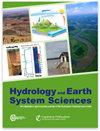西藏南部内流河流域近期地热-水文变化及其对湖泊水位变化的影响
IF 5.8
1区 地球科学
Q1 GEOSCIENCES, MULTIDISCIPLINARY
引用次数: 0
摘要
摘要气候变化改变了青藏高原(QTP)等山区大气与地表之间的水和能量通量,在过去几十年中,青藏高原的水文发生了巨大变化,包括湖泊水位的快速变化。整个青藏高原的地面要么是永久冻土层,要么是季节性冰冻,在这种环境下,地热状态影响着液态水的供应、蒸发和径流。因此,气候引起的地热变化可能会导致湖泊水位的变化,但这一假设的正确性还有待证实。本研究侧重于 1980-2019 年期间白湖(西藏南部)集水区的低温水文学。我们利用降尺度和聚类工具(TopoSCALE、TopoSUB)对ERA5数据进行处理,以考虑我们的强迫数据中气候的空间变异性(Fiddes 和 Gruber,2012 年,2014 年)。我们使用 CryoGrid 群体模型(1.0 版)的分布式设置来量化这一时期地面的热-水文变化。我们利用气象站数据、地表温度记录仪和湖泊水位变化观测数据对强迫数据和模拟输出进行了验证。我们的湖泊预算重建显示,湖泊的主要水输入是直接降水(310 毫米/年-1),其次是冰川径流(280 毫米/年-1)和陆地径流(180 毫米/年-1)。然而,所有这些因素都无法抵消蒸发量(860 毫米/年-1)。我们的研究结果表明,季节性冻土和永久冻土都变暖了(每十年 2 米深 0.17 ∘C),增加了地下液态水的可用性和季节性解冻的持续时间。与年度值的相关性表明,这两种现象都促进了蒸发和径流。然而,地表变暖导致地表下径流剧增,从而使径流/(蒸发+径流)比值随时间增加。这种增加可能有助于稳定 2010 年后湖泊水位的下降。夏季蒸发是一个重要的能量汇,只有在蒸发有限的地方,我们才会发现活动层加深。研究发现,永久冻土的存在会促进蒸发,而以径流为代价,这与最近的研究结果一致,即浅层活动层可保持接近地表的较高含水量。不过,这种关系似乎与气候有关,我们的研究表明,较冷和较湿的气候会产生相反的效果。虽然本研究是在集水区范围内进行的,但我们认为永久冻土的这种矛盾影响可能有助于理解在 QTP 南部和北部观察到的截然不同的湖泊水位变化,为未来的研究开辟了新的视角。本文章由计算机程序翻译,如有差异,请以英文原文为准。
Recent ground thermo-hydrological changes in a southern Tibetan endorheic catchment and implications for lake level changes
Abstract. Climate change modifies the water and energy fluxes between the atmosphere and the surface in mountainous regions such as the Qinghai–Tibet Plateau (QTP), which has shown substantial hydrological changes over the last decades, including rapid lake level variations. The ground across the QTP hosts either permafrost or is seasonally frozen, and, in this environment, the ground thermal regime influences liquid water availability, evaporation and runoff. Consequently, climate-induced changes in the ground thermal regime may contribute to variations in lake levels, but the validity of this hypothesis has yet to be established. This study focuses on the cryo-hydrology of the catchment of Lake Paiku (southern Tibet) for the 1980–2019 period. We process ERA5 data with downscaling and clustering tools (TopoSCALE, TopoSUB) to account for the spatial variability of the climate in our forcing data (Fiddes and Gruber, 2012, 2014). We use a distributed setup of the CryoGrid community model (version 1.0) to quantify thermo-hydrological changes in the ground during this period. Forcing data and simulation outputs are validated with data from a weather station, surface temperature loggers and observations of lake level variations. Our lake budget reconstruction shows that the main water input to the lake is direct precipitation (310 mm yr−1), followed by glacier runoff (280 mm yr−1) and land runoff (180 mm yr−1). However, altogether these components do not offset evaporation (860 mm yr−1). Our results show that both seasonal frozen ground and permafrost have warmed (0.17 ∘C per decade 2 m deep), increasing the availability of liquid water in the ground and the duration of seasonal thaw. Correlations with annual values suggest that both phenomena promote evaporation and runoff. Yet, ground warming drives a strong increase in subsurface runoff so that the runoff/(evaporation + runoff) ratio increases over time. This increase likely contributed to stabilizing the lake level decrease after 2010. Summer evaporation is an important energy sink, and we find active-layer deepening only where evaporation is limited. The presence of permafrost is found to promote evaporation at the expense of runoff, consistently with recent studies suggesting that a shallow active layer maintains higher water contents close to the surface. However, this relationship seems to be climate dependent, and we show that a colder and wetter climate produces the opposite effect. Although the present study was performed at the catchment scale, we suggest that this ambivalent influence of permafrost may help to understand the contrasting lake level variations observed between the south and north of the QTP, opening new perspectives for future investigations.
求助全文
通过发布文献求助,成功后即可免费获取论文全文。
去求助
来源期刊

Hydrology and Earth System Sciences
地学-地球科学综合
CiteScore
10.10
自引率
7.90%
发文量
273
审稿时长
15 months
期刊介绍:
Hydrology and Earth System Sciences (HESS) is a not-for-profit international two-stage open-access journal for the publication of original research in hydrology. HESS encourages and supports fundamental and applied research that advances the understanding of hydrological systems, their role in providing water for ecosystems and society, and the role of the water cycle in the functioning of the Earth system. A multi-disciplinary approach is encouraged that broadens the hydrological perspective and the advancement of hydrological science through integration with other cognate sciences and cross-fertilization across disciplinary boundaries.
 求助内容:
求助内容: 应助结果提醒方式:
应助结果提醒方式:


